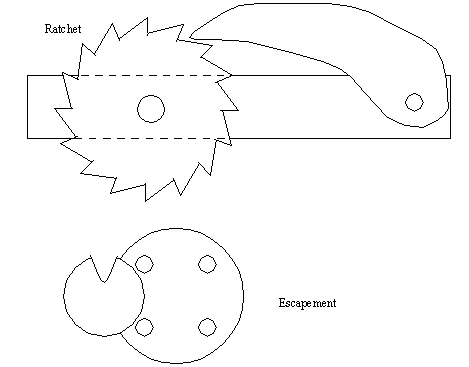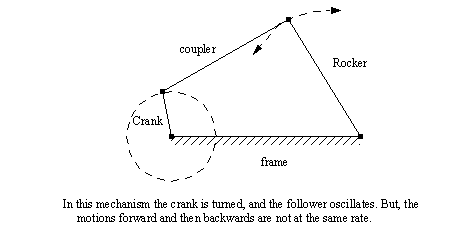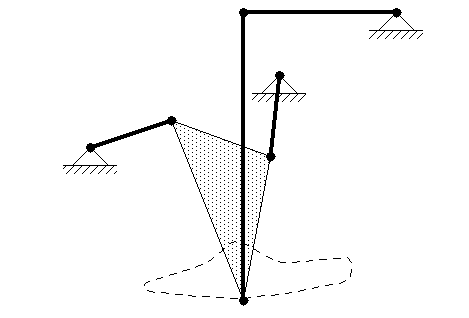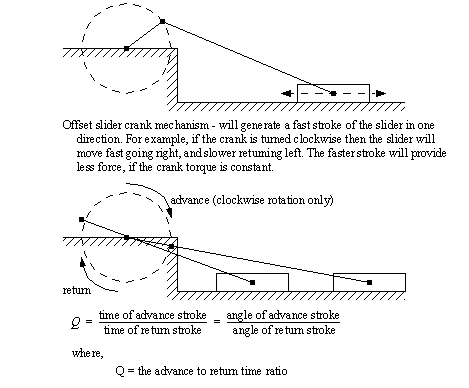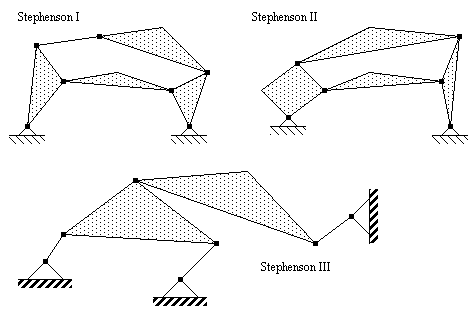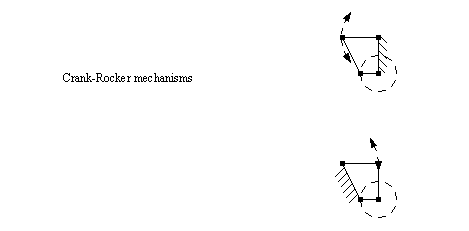8.1 Mechanisms
• Consider a pair of adjustable vice grips.
•Some definitions,
Machine - a collection of components that will do work.
Mechanism - a collection of components to transform motion
Kinematics - consider positions/velocities/accelerations in mechanical systems
Structure - a collection of components to make larger static structures
Statics - estimate forces in mechanisms that are in equilibrium
Dynamics - determine motion that results when forces are out of balance
Link - rigid body between joints
Binary Link - has two joints only
Ternary Link - has three joints
Quaternary Link - has four joints
Pair or Joint - a connection between two links
Driver / Follower - the driver link will be driving the follower
Kinematic Chain - a sequence of links making up a mechanism
Open Loop - a snake like set of connected links
Closed Loop - a kinematic chain has one or more links that go back in the chain
Frame - a grounded or fixed link in a mechanism
Spatial - in 3 dimensions
Relative/Absolute - a position, velocity, etc. is measured based on a fixed (absolute) or moving (relative) point.
• A Degree Of Freedom (DOF) is an independently controllable variable. As an example, a machine that has two degrees of freedom might need two motors to control it.
• Lower Pairs, - constrained position/orientation of both sides of the joints are identical
Turning / Revolute - basically a pin joint (R)
Prismatic - a slider (P)
Screw/Helix - a nut and screw pair (H)
Cylindric - a shaft in a collar (C)
Globular/Spherical - a ball joint (S)
• Higher pairs include, - typically other equations are needed to constrain the joints, such as gear ratios (if the joint has more than a single degree of freedom)
- flat/planar - constrained to move over a plane
- belt on pulley
- meshing gears
- sliding wheel on a surface
- etc.
• The definition of higher/lower pairs given in Shigley [1995] is, “the lower pairs, such as the pin joint, have surface contact between the pair elements, while higher pairs, such at the connection between a cam and its follower, have line or point contact between the surface elements.” They go on to point out that the definition is not exact, which is somewhat disappointing.
• A better definition of a higher pair is - A higher pair is not a lower pair, where a lower pair permits the following relative motions between links; circular, linear, helical, cylindrical, spherical, planar.
• If a link has one joint, it is a unary link. A link with two joints is binary, with three it is ternary, with four it is quaternary, etc.
• Planar linkages use lower order pairs, and are constrained to a single plane of motion.
• Some basic mechanism types are listed below, and split into some suggested categories
8.1.1 Locking/Engaging
Snap-action mechanisms - typically bistable mechanisms, such as electrical breaker switches, or toggle mechanisms such as XXXX
Clamping Mechanisms - vices, collets, etc.
Locational Devices - self alining/centering devices
Ratchets and Escapements - A locking mechanism, like a ratchet wrench or winch
Indexing Mechanisms - e.g. the geneva mechanism
Reversing Mechanisms - A mechanism that can disengage a transmission, and reverse direction of transmission
8.1.2 Motion Transmission/Transformation
Linear Actuators - produce a straight line motion. can be done with threads, or hydraulic cylinders
Fine Adjustments - screws, wedges, etc. - these can overcome imperfections during manufacture
Couplings and Connectors - transmit rotations between rotating shafts. e.g. pulleys and belts
Sliding Connectors - transmit linear motions in different directions
8.1.3 Four Bar Linkages
Swinging or Rocking Mechanism - produce cyclic motions
Stop/Pause/Hesitation - a motion is produced that appears to come to a stop for a short period of time.
Curve Generators - mechanisms set up to follow complex paths - typically four bar linkages.
Straight Line - mechanisms are set up to generate straight line motions
8.1.4 Reciprocating
Reciprocating Mechanisms - converts a rotational motion to a linear motion
8.1.5 Six Bar Linkages
• These allow more complex motion, especially when ternary links are used.
• In Watt linkages there are two ternary links touching,
• In Stephenson linkages the terary links don’t touch,
•. Consider the equation, and the four basic kinematic inversions below. Keep in mind that the crank will be the shortest link, with length ‘s, and in all four cases will rotate continuously.

